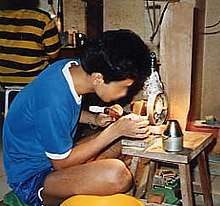Gemcutter
A gemcutter is a person who cuts, shapes, and polishes natural and synthetic gemstones. In historical use it usually refers to an artist who made hardstone carvings or engraved gems, a branch of miniature sculpture or ornament in gemstone.

Among a modern gemcutter's work are the following activities:
- Positioning rough stone in a holder, and holding the stone against the edge of a revolving saw or lapidary slitter impregnated with diamond dust to cut and slit stone.
- Removing cut stone and placing it in lapidary stick. A gemcutter then selects the shaping wheel and applies abrasive compound. They hold a lapidary stick against the revolving shaping wheel and lapidary disk to further shape stone and grind facets.
- Examining stone for accuracy of cut, using a magnifying glass. A gemcutter polishes stone, using felt or canvas-covered polishing wheel, and polishing compounds, such as tripoli or jeweler's rouge.
- Possibly using a mechanical facet-cutting device. A gemcutter may cut and polish diamonds for industrial purposes, and be designated as an Industrial-Diamond Polisher (jewelry-silver.).
Gemcutting
The term gemcutting is used to describe the process of shaping and polishing faceted gemstones. The artisan undertaking the cutting can also be called a lapidary.
While the gemstone in the rough state may be trimmed to remove undesirable material or to separate it on a cleavage line with a diamond bladed saw, accurately described as cutting and once done by the use of a chisel or similar tool to simply break off pieces that were usable as single gemstones.
The actual shaping and polishing of a gemstone is a grinding or sanding process. This grinding and sanding is done using a lap, a precision metal plate embedded with grit similar to the more familiar embedding of grit on paper the lap is of high precision particularly for flatness and turned by a motor. (See faceting equipment) The grit material is normally diamond and sometimes corundum for their hardness. Only diamond is hard enough on the Mohs scale to shape and polish a diamond.
The initial shaping and facet placement may be done using laps with the more familiar grits of 220, 600, 1200. The polishing step, however, requires grits that are less familiar 8,000 14,000 50,000 and even 100,000. This grit is also embedded into a metal lap, but sometimes applied manually to the lap during polishing.
Equipment of Faceting
Faceting requires equipment allowing for very precise adjustment of angle and location around the gemstone for facet-placement, this process can be referred to as indexing. The design may be computer-generated or left up to the skill and expertise of the individual cutting the gemstone.
During the process of grinding, faceting, and lapping, the gemstone is usually affixed ("dopped") to a rod (frequently referred to as a "dop" or "dopstick") made of wood, or perhaps brass or steel, with dopping cement, a specialized thermal adhesive. The dopstick can be hand-held or inserted into the indexing equipment for more precise faceting. A coolant then needs to be constantly applied to prevent softening of the cement.
Diamonds however are held mechanically, or with low-melting point tin-lead solder, since the resultant heat generated by friction can be extreme and won't allow the use of thermal adhesives.
Cabochons, smooth-shaped gemstones without facets such as jade or turquoise, and indeed most gemstones, are instead shaped and polished in much the same manner, however are usually left up to the skill and expertise of the individual cutting the gemstone and to similar equipment such as the lapping equipment.